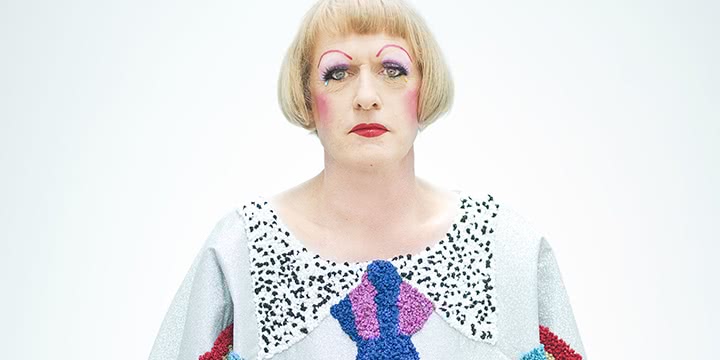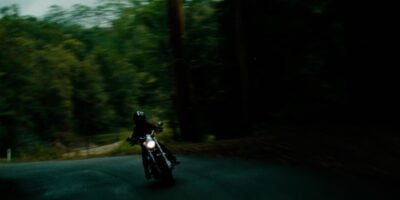In addition to having a name divinely suited to the detective novels he reads to unwind, Grayson Perry is about as colourful as they come.
The Turner Prize-winning artist has been celebrated across the globe, and now the Museum of Contemporary Art is staging the very first major exhibition of Perry’s work in the Southern Hemisphere. Best known for his vibrant, occasionally explicit ceramics, the recently appointed Chancellor of the University of the Arts London has been at the forefront of contemporary art for decades. Yet as he explains, the composite of Grayson Perry – between his transvestism, his art, his scholarly work, his private life – is a complicated, overlapping affair, and what he is best known for today may not stay that way forever.
“We all have a portmanteau identity,” Perry reflects. “All of us are parents, children, brothers, sisters, colleagues, playmates. I have a whole series of identities – it’s something I’ve looked into. There’s a kind of hierarchy of who we are. Gender, for instance, is very fundamental to the sense of who you are, whereas something like, say, our level of education is a bit more superficial. There are many different influences on who you are, so I always imagine I’m a kind of group of people. Have you seen the last Pixar film, Inside Out? It’s great. I think that’s rather what it’s like – we all have a bit of a boardroom in our head, each person trying to be in control.”
A great number of interviews and essays on Perry tend to open with a variation on the phrase, “Artist and transvestite Grayson Perry…”, as though they are very distinct aspects who only ever meet at family holidays. But across Perry the ceramic artist, Perry the artist in tapestry and paper, Perry the transvestite, Perry the guy who does the Sunday crosswords, there remains a common font. He is an artist driven to create, but it is a compulsion he has found must be cultivated and encouraged.
“You have to be disciplined. No artist ever gets anywhere without being disciplined; it’s the only way to get things done. The idea of some chaotic Bohemia is a nice myth, but I don’t think it really exists. You’re not going to climb the greasy pole of the art world that way. What I’m very interested in is the mechanics of the art world. I think people think that art just kind of appears somehow, that it’s all just very natural and easy. But nothing is natural and easy – it’s all very self-conscious, it’s often a grind.
“There’s this idea that anything that makes its way into a gallery is art. I remember a couple of decades ago, photography was everywhere in the art world; it seemed like every second exhibition was photography. And the tide of that has to a certain extent receded, and some photographers made it. Some, of course, didn’t.”
It is an old punchline these days: the person admiring a sculpture on the wall of a gallery, only to discover it is actually the air conditioner. ‘Art’ is a complicated word, and the ways in which a piece attains cultural significance can be labyrinthine. Perry’s first exhibition of ceramics was back in 1983, and as his career and canvas have expanded, he has witnessed the development of contemporary art – and the ways in which it is validated – from close quarters.
“You have curators probably at the head of the table; somebody once described them as the Popes of art. The curators of big museums have a lot of power, they can give that stamp of authority. The MCA having my exhibition now, that’s a big stamp of authority for me [and] my validation as an artist. From there you have dealers and collectors, other artists, teachers, the media. All these people form the voices of ‘Yes, this is art, and this is good.’ It’s a field you need to move through strategically and somewhat intuitively.
“If there’s one phrase that fills me with dread, it’s ‘global culture’. That’s a disastrous idea – I don’t think any artist should ever worry about that. I’ve just been putting together my talk for the Opera House, and I quote W.H. Auden who said, ‘A poet’s hope: to be, like some valley cheese, local, but prized elsewhere.’” Perry laughs. “That’s how I see it. You make work for who you are, where you are, when you are. Raphael, Picasso, they didn’t worry about being a global artist. They just got on with doing what they were in response to the world they inhabited. Of course, there are now certain sorts of artists who are very much global figures, and increasingly we’re seeing a style of international ‘superstar art’, you might call it.”
With My Pretty Little Art Career set to open next week, already Perry has found himself in contentious water. Having visited the Royal Academy’s 2013 survey exhibition of Australian art and the Indigenous Australia exhibition at the British Museum, he commented on the appropriateness of indigenous art being considered contemporary. When it is a continuation of a very long tradition, he seemed to suggest, can it still be discussed and showcased in a contemporary art context? It was a question that received an immediate backlash here in Australia, taking Perry sadly by surprise.
“I know I’ve said a few clumsy things. I think I phrased it wrong. I’m really just interested in the way things become contemporary art, because lots of things sort of shuffle into the contemporary art world, and some make it and some don’t. I’ve talked a lot about it in my lectures, how things become art. When I talk about Aboriginal art, I should have been more specific, and I was thinking of the more traditional style of dot paintings on canvas. I’m not saying all Aboriginal art can’t secure a foothold in contemporary art. An Aboriginal person who goes to art school is just as likely to become a contemporary artist as anyone else.
“You’re dealing with a very oppressed minority, so the normal rules don’t apply. The rough-and-tumble of cultural dialogue perhaps needs to be shelved, and I think I made a bit of a boo-boo there. But I’m quite happy to talk it through with anyone who wants to talk about it.”
Though his own work has been heralded for its autobiographical nature, these days Perry is less inclined to mine his own life for inspiration. Rather, he prefers to turn to the world at large, to find creative sustenance in unexpected places. At the end of the day, though, it still comes down to dedication and faith.
“I quite often have a fairly well-resolved vision of what something is going to be. An out-of-focus, slightly hazy vision from the off, and the difficult process is trying to bring that into focus. All of the detail, the practicalities. Often an idea will be mostly complete, but sometimes I have to hack away at it for ages, trying different versions to get it right. But it’s all organic, there’s no real method. You just have to be good at spotting when things are happening, to treat your ideas with respect and not dismiss them.”
[Grayson Perry photo Pal Hanson
Grayson Perry: My Pretty Little Art Career runsThursday December 10 – Sunday May 1 at theMuseum of Contemporary Art.

































